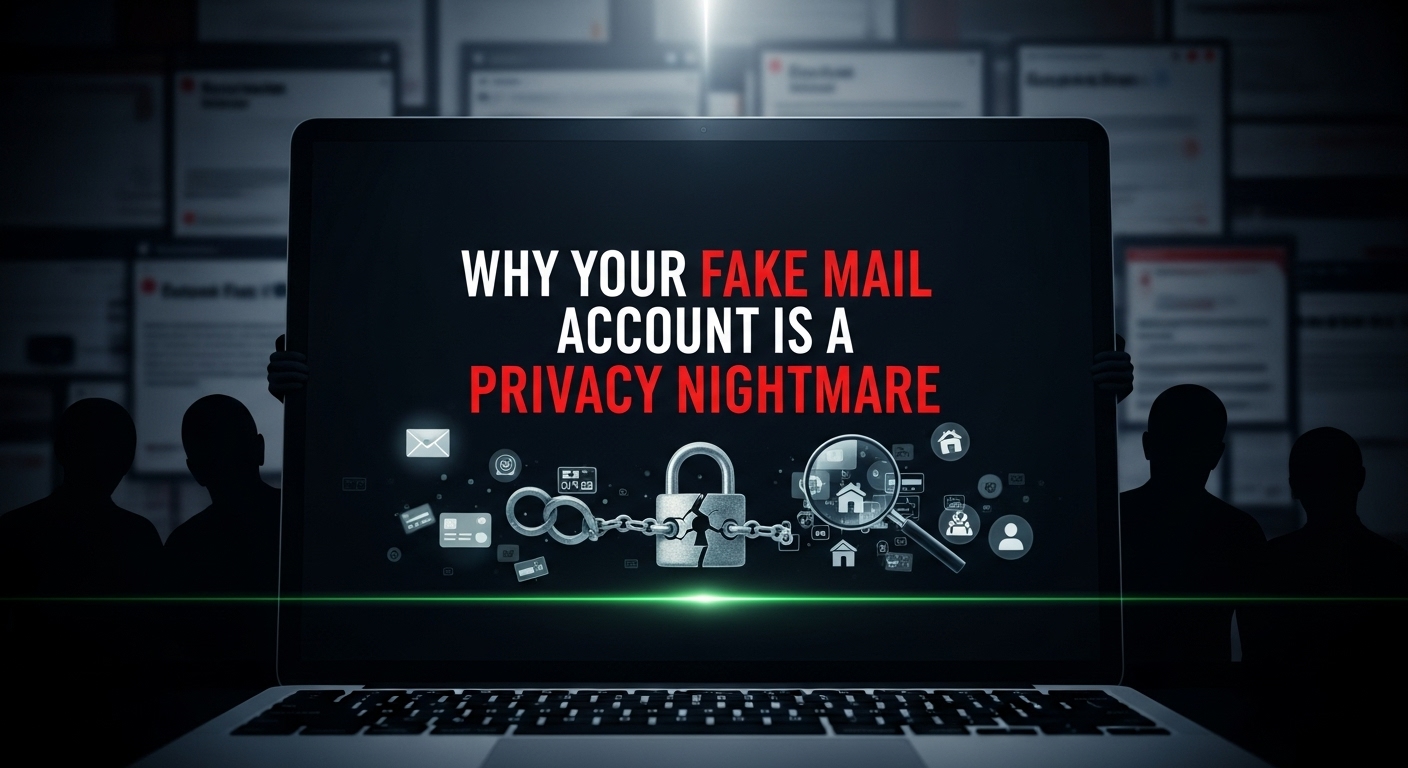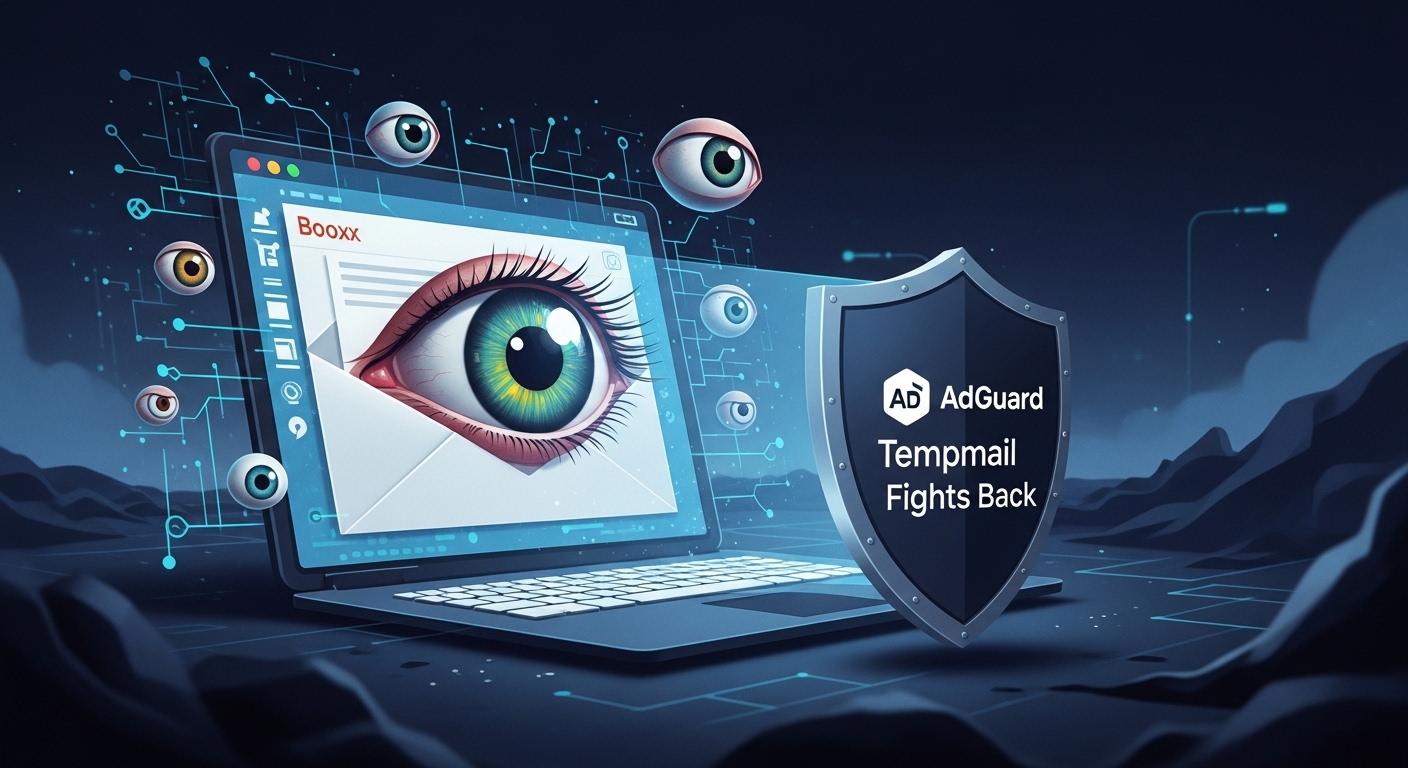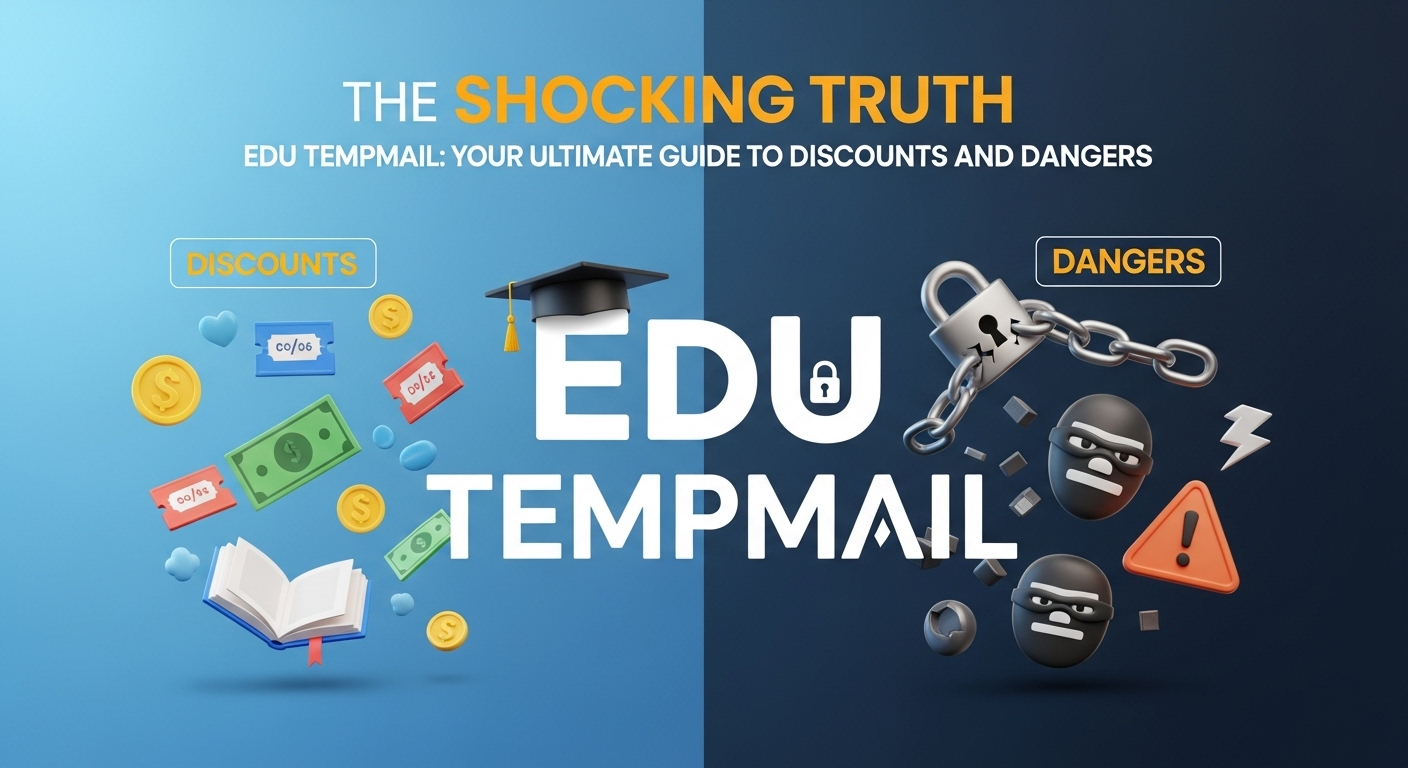Why Your Fake Mail Account Is a Privacy Nightmare

You’ve found the perfect e-book. Maybe it’s a 20% off coupon for that new gadget you’ve been eyeing. Or perhaps it’s a free trial for a must-have software. But there’s always a catch: you have to hand over your email address. Instantly, you can picture the future—a primary inbox drowning in a sea of promotional spam.
The temptation is overwhelming. You open a new tab and search for a "fake mail" generator. In seconds, you have a temporary, anonymous address. You get your freebie, and your real inbox stays pristine. It feels like the perfect solution, a clever hack to beat the system.1
But what if that convenient solution is actually a trap? What if that shield for your privacy is full of holes?
This is the most comprehensive, data-backed guide on the internet about fake mail. We will pull back the curtain on disposable email services. We'll explore the good, the bad, and the outright dangerous. With nearly half of all global emails being spam and the average cost of a data breach soaring to $4.88 million, protecting your digital identity has never been more critical.3 Get ready to discover why your trusty fake mail account might be your biggest privacy nightmare.
What Exactly Is a Fake Mail Address?
First, let's clear up the confusion. "Fake mail" is a catch-all term for a service that provides a temporary email address. You might also know it by other names, which all mean roughly the same thing:
- Disposable email
- Burner mail
- Throwaway email
- Temp mail
- 10-minute mail
Think of a disposable email like a public sticky note. You can write a temporary address on it, stick it on a public bulletin board to receive a message, and then watch it get thrown away. It’s designed to receive a quick note and then vanish, leaving no trace connected to you... or so it seems.
These services work by registering thousands of domain names. When you visit their website, they instantly generate a random email address on one of those domains and give you access to a temporary, web-based inbox. The best part? It requires no registration, no password, and no personal information, which is the source of its massive appeal.
Why Millions Flock to Fake Email Generators
It’s no secret why these services are so popular. They solve real, everyday problems that frustrate internet users. Let's be honest, you've probably used a fake mail generator for one of these reasons.
Benefit 1: The Ultimate Spam Shield
This is the number one reason people use disposable emails. With over 3.4 billion spam emails sent every single day, our inboxes are under constant assault. A fake mail address acts as a powerful shield.
Real-life examples include:
- Signing up for a retailer’s coupon: You get that 15% off without a lifetime of marketing emails.
- Downloading a free resource: You access that valuable e-book or guide without joining a newsletter you’ll never read.
- Entering an online contest: You get a chance to win without your real email being sold to marketing lists.
Benefit 2: A Cloak of Digital Privacy
Your primary email is more than just an address; it’s a key to your digital identity. It’s often linked to your full name, phone number, and countless online accounts. With 85% of adults wanting to do more to protect their online privacy, using a fake mail address feels like a smart way to regain control.
It's perfect for situations where you don't want to reveal your true identity, such as:
- Participating in public forums or discussion groups.
- Signing up for online dating sites.
- Communicating on marketplaces like Craigslist or Facebook Marketplace.
Benefit 3: Sandbox for the Web—Testing Without Consequence
For developers, testers, and the tech-savvy, disposable emails are an invaluable tool. They allow you to test application sign-up flows, check out a new service without commitment, or even bypass free trial limitations (though this often violates a site's terms of service).1
| Pros (The Perceived Benefits) | Cons (The Hidden Dangers) |
| ✅ Keeps your primary inbox clean from spam. | ❌ Permanent Account Loss: No password resets or 2FA. |
| ✅ Provides a layer of anonymity for sign-ups. | ❌ Zero Real Privacy: Inboxes are often public and unencrypted. |
| ✅ Fast and requires no registration. | ❌ Frequently Blocked: Many websites reject disposable domains. |
| ✅ Useful for one-time downloads or trials. | ❌ Security Risks: Vulnerable to hacking and data scraping. |
5 Critical Dangers of Using a Fake Mail Service
Here is where the illusion shatters. That quick and easy solution comes with severe, often overlooked, risks that can compromise your security and cost you dearly.
Danger 1: The Permanent Lockout Trap
This is the single biggest danger of using a fake mail service. When that temporary email expires, it’s gone forever. This means you lose the ability to ever receive a password reset link, a two-factor authentication (2FA) code, or a critical security alert for any account you created with it.
Real-Life Example: Imagine you use a fake mail address to sign up for a cool online design tool. You spend weeks creating amazing projects. One day, you forget your password. Because the email you used to register now longer exists, you are permanently locked out. Your account, and all your hard work, are gone forever.
Danger 2: The Illusion of Privacy—Your Mail Is Not Secret
This is the ultimate betrayal. You use a fake mail service for privacy, but in many cases, it offers none.
- Public Inboxes: Many free services operate with public inboxes. This means anyone who guesses or knows your temporary address can access your inbox and read your messages. It’s the digital equivalent of sending a postcard instead of a sealed letter.
- No Encryption: The vast majority of these services do not use end-to-end encryption. Your emails, including verification links and confirmation codes, sit on their servers in plain text, vulnerable to hackers, snooping, or a data breach of the service itself.
- IP Logging: Anonymity is a myth. Most of these "anonymous" services log your IP address and browser details. In the event of a legal investigation, this data can be used to trace the activity directly back to you.
Danger 3: The Blacklist Barrier—"This Email Is Not Allowed"
Websites are fighting back. Service administrators use tools that maintain massive, constantly updated blocklists of domains known to be from disposable email providers. This means that more and more, when you try to use a fake mail address, you’ll be met with an error message. The tool becomes unreliable precisely when you need it.
Danger 4: A Gateway for Fraud and Phishing
Disposable emails are the tool of choice for cybercriminals. They use them to create fake accounts in bulk, send phishing emails, and evade bans after being caught. This creates a "reputational contagion." When you use an address from a domain that is heavily used by spammers, your email is automatically seen as suspicious. Even with good intentions, you are associating yourself with a digital "bad neighborhood," and your messages are more likely to be blocked or sent straight to the spam folder.
Danger 5: Zero Support and Accountability
If you use a fake mail address to buy something online and there's a problem with your order, you have no recourse. The merchant can't contact you to provide support, and you can't prove you own the account to get a refund or claim a warranty. You are completely on your own.
Are Any Disposable Email Services Safe?
So, are any of these services worth using? We reviewed some of the most popular names in the fake mail space to see how they stack up against the dangers we've outlined.
| Service | Key Feature | Privacy Grade | Security Grade | Reliability Grade | Best For |
| Temp Mail | Instant, no-signup inbox | D (IP logging, ads) | F (No encryption, public domains) | C- (Frequently blocked) | Quick, non-sensitive verification codes. |
| 10 Minute Mail | Self-destructs in 10 mins | D (IP logging, public inboxes) | F (No encryption, passwordless) | D (Aggressively blocked) | Extremely short-term, one-time use. |
| Guerrilla Mail | Can send & receive | F (Public, guessable inboxes) | F (No encryption, old tech) | C (Less commonly blocked) | Anonymous (but not private) sending. |
| AdGuard Temp Mail | Ad-free interface | C (Hides IP from sender) | D (No encryption, basic security) | C (From a known security brand) | Users who prioritize an ad-free experience. |
The verdict is clear: for any task that requires even a minimal level of security, privacy, or long-term access, traditional fake mail services are not safe.
Conclusion: Reclaim Your Inbox, The Smart Way
The appeal of a fake mail generator is undeniable. In a world of constant spam and data breaches, it feels like a necessary defense. However, the truth is that most disposable email services trade your long-term security for short-term convenience. The risks of permanent account loss, non-existent privacy, and unreliability are simply too high for anything that matters.
Stop gambling with your digital identity. It's time to ditch the risky public burners and embrace the control, security, and peace of mind that comes with email aliases. Your future self—the one who can still access all their accounts—will thank you.
Frequently Asked Questions (FAQ) About Fake Mail
- What is a fake mail address?
A fake mail address, also called a disposable or temporary email, is a short-term inbox used to receive messages without exposing your real email. Services generate a temporary address that typically self-destructs after a set time. - Is it legal to use a fake mail generator?
Yes, using a temporary email for privacy is legal in most places. However, using it for illegal activities, fraud, or violating a website's terms of service is not. The legality depends entirely on your intent. - Can fake mail be traced?
It is difficult but not impossible. While they provide a layer of anonymity, most services log your IP address. For serious criminal investigations, law enforcement can subpoena these logs to trace the email back to the user. True anonymity is very hard to achieve.19 - What is the safest temporary email service?
No public disposable email service is truly "safe" for sensitive information, as most lack encryption and have public inboxes. Safer alternatives are email alias services from reputable privacy companies like Proton (which owns SimpleLogin) or Fastmail, which protect your real inbox with better security. - Why do websites block temporary emails?
Websites block disposable email domains to prevent abuse. These addresses are often used to exploit free trials, create spam accounts, and engage in fraudulent activity, leading to low-quality users and security risks for the service. - What's the difference between a fake mail and an email alias?
A fake mail address usually comes with a temporary, often public, inbox that expires. An email alias is a permanent, private forwarding address that you control. It directs mail to your real inbox, allowing you to reply and manage messages securely while keeping your main address hidden. - Can I send email from a fake mail address?
The vast majority of free disposable email services are receive-only to prevent them from being used for spam and abuse. A few, like Guerrilla Mail, have limited sending capabilities, but this is rare. - What happens when a temporary email expires?
When a temporary email expires, the address and its entire inbox are permanently deleted. Any emails sent to it will bounce, and you will lose all ability to access any account associated with it. - Should I use a fake mail for social media accounts?
No, this is highly discouraged. If you ever get locked out of your social media account or need to verify your identity, you will be unable to do so once the temporary email expires, resulting in the permanent loss of your account. - How can I protect my real email address without using fake mail?
The best method is to use an email alias service. You can also use the built-in features of Gmail (+ addressing) or iCloud (Hide My Email). Additionally, using strong, unique passwords with a password manager and enabling two-factor authentication on all your accounts are crucial best practices.For further reading on this topic, check out PCMag's excellent breakdown of(https://www.pcmag.com/picks/the-best-temporary-email-services).
Please don’t forget to leave a review of my article.
You Might Also Like
Is Your Inbox Spying on You? Here’s How AdGuard Tempmail Fights Back
Have you ever paused before entering your email address into a new website, feeling a slight hesitation? That feeling is...

The Shocking Truth About Edu Tempmail: Your Ultimate Guide to Discounts and Dangers
Imagine getting over 60% off Adobe Creative Cloud and half-price Amazon Prime. What if you could get those deals without...

Why Your Hotmail Is a Privacy Nightmare (And How Temp Mail Can Save You)
Did you know that nearly half of all emails sent worldwide are spam? In 2024, spam accounted for a staggering 47.27% of ...

The Ultimate Deception: Is Tempmail Safe, or a Ticking Time Bomb?
Your email inbox is more than just a place for messages. It's the digital key to your entire online life. Every password...

The Ultimate Betrayal: How Your Inbox Is Selling You Out (And How to Use Tempmail to Stop It)
Your inbox is a battlefield. Every single day, a war is waged for your attention, your data, and your money. Don't belie...

Your Digital Shield: The Astonishing Truth About How Temp Mail Works
Opening your email inbox can feel like walking into a battlefield. You’re constantly dodging a barrage of promotional ju...

